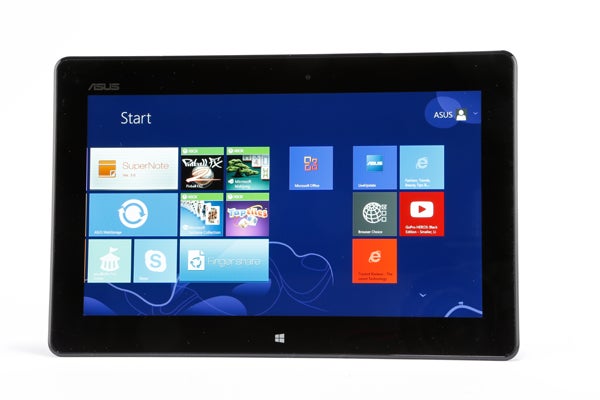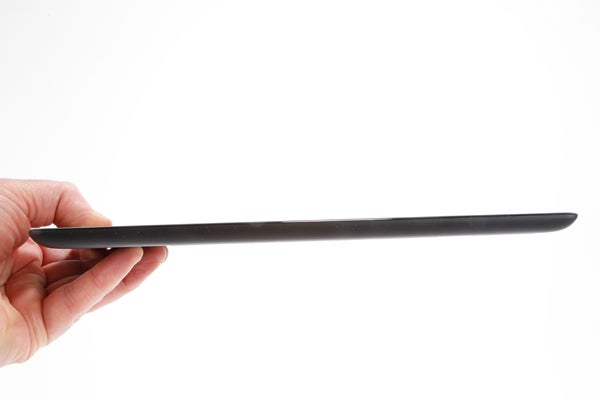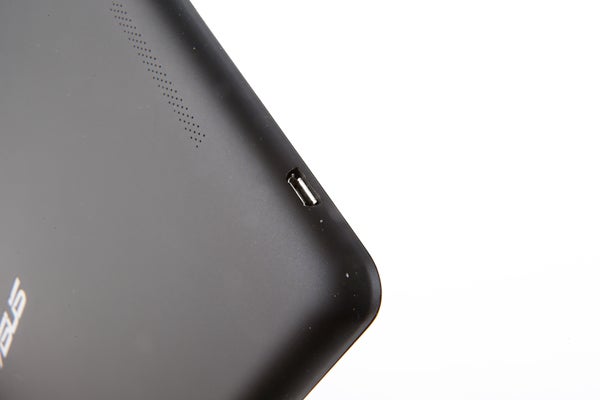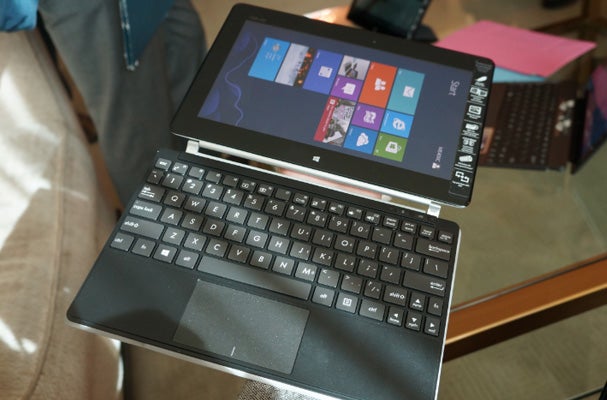Asus VivoTab Smart Review
Asus VivoTab Smart
A full Windows 8 tablet that is cheaper than the Microsoft Surface RT.

Sections
- Page 1 Asus VivoTab Smart Review
- Page 2 Battery Life, Performance and Apps Review
Verdict
Pros
- Slim body
- Reasonable price
- Full Windows 8
Cons
- Low pixel density
- Low-powered CPU
- Laggy at times
- Poor internal speaker
Key Specifications
- Review Price: £400.00
- Dual-core Atom Z2760 CPU
- 64GB memory (32GB accessible)
- 10.1-inch 1,366 x 768 pixel IPS screen
- microSD slot
- Windows 8 OS
Introduction
Windows 8 tablets face a raft of problems. Few tablet buyers know the difference between “full Windows 8” and Windows RT, the platform is recognised as a tablet platform much less than Android or iOS and many Windows tablets are expensive.
The Asus VivoTab Smart tries to side-step these issues. It’s a 10.1-inch full Windows 8 tablet that costs just £400, the same price as the cheapest full-size iPad with Retina Display.
Asus VivoTab Smart – Design and Specs
The Asus VivoTab Smart can offer full Windows 8 at a pretty low price because it uses a lower-power Intel Atom CPU and unassuming design. Higher-end Windows 8 tablets use Intel Core-series processors, from the same family as those seen in expensive laptops. They’re in a different league to the Intel Atom chip seen here.

Its bodywork is functional and sensible too – there are few design embellishments. The Asus Vivotab Smart is as slim and light as Android tablets of the same size, at 570g and 9.7mm thick, and its rear is soft-touch finish plastic.
This type of plastic feels great in-hand, but doesn’t leave the same impression of luxury as the anodised aluminium of an iPad. It’s also prone to damage. 
Scratches strip away the black/brown finish to reveal the white plastic underneath, and the styling is limited to the off-black colour of the rear and Asus logo on the back. The Asus VivoTab Smart is not out to become a tablet whose bodywork sticks in your mind for years to come.
Asus VivoTab Smart Video Review >
As a 10.1-inch 16:9 aspect tablet – making it 26cm long – this tablet is also a little too large to be truly portable. It’s best thought-of as a device to use at home or while sitting down on the bus/train, rather than when standing up on public transport with one arm clutching a rail. For that you’re better off with an iPad mini or Google Nexus 7. There is no super-portable Windows tablet, yet.
Unassuming design is met by mid-level specs. Its CPU is a 1.8GHz Intel Atom Z2760 dual-core chip, it has 2GB of RAM and 64GB of internal storage. In an Android tablet those memory figures would sound impressive, but they are less so here.
The Asus VivoTab Smart runs an OS that will often have 8GB of RAM at its disposal, and after Windows 8 and Asus’s own apps have taken their share of the internal storage, you’re left with just a shade over 30GB of the initial 64GB.
Asus VivoTab Smart – Connectivity
What helps to mitigate the memory-chomping of Windows 8 is the microSD card slot on the left edge of the Asus VivoTab Smart. It uses a cover that blasts out like a rocket when prodded with a fingernail, though, so be sure to act with care unless you want to lose it.
Next to the memory card slot sits a microHDMI video output. Also on this edge is the microUSB slot, used to charge the battery.

This spread of connections sounds just about perfect for a tablet, but it’s less well-equipped than you might assume. As Windows 8 is a “computer” OS rather than a tablet one, its internal storage doesn’t simply show up as a drive when the Asus VivoTab Smart is attached to a computer. You’ll need to move files to a microSD memory card to get them over to the tablet.
A full-size USB socket or SD card slot comes in extremely handy with a Windows 8 tablet, and you get neither here. A USB port is not only handy for storage either – it would also let you plug in a mouse or keyboard. Asus also produces a neat Bluetooth keyboard cover for the tablet that attaches magnetically, but this is an optional extra.
Wireless connectivity fares better. The Asus VivoTab smart has the tablet standards Wi-Fi and Bluetooth, as well as GPS and NFC.
Asus VivoTab Smart – Screen
The Asus VivoTab Smart uses a typical tablet-style display. It features an IPS screen, which lets you turn the screen any which way you please without the image distorting or disappearing – as it would on most laptops. 
The screen is 10.1 inches across and has a resolution of 1,366 x 768 pixels. This results in pixel density of 155ppi, well below the resolution of rival tablets like the iPad with Retina Display and Google Nexus 10. As a result, text is slightly pixellated.
This is true of all Windows 8 tablets at this price – only more expensive tabs such as the Surface Pro offer full HD resolution screens at present – but if you’ve used a high pixel density screen, you will notice it.
Image quality is decent, with just a slight yellow colour cast to whites and acceptable loss of brightness when angled. Top brightness could be higher, though.
Like so many other aspects of the Asus VivoTab Smart, the screen isn’t high-end, but it pays enough attention to the basics to get by. It is coated with an oleophobic (fingerprint-resistant) coating, uses toughened glass and, thanks to the IPS panel, offers enough viewing angle flexibility for the ways in which a tablet is used.
Top marks? Far from it, but the VivoTab Smart matches its entry-level Windows 8 competitors.
How we test tablets
We test every tablet we review thoroughly. We use industry standard tests to compare features properly and we use the tablet as our main device over the review period. We’ll always tell you what we find and we never, ever, accept money to review a product.


